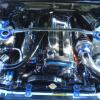Should I Fit The Biggest Oil Cooler I Can?
Announcements
-
Similar Content
-
Latest Posts
-
After using a protractor for an actually accurate assessment of what is required, and by NOT using my uncalibrated eyeball I worked out I need a 25° silicone bend from the TB ro the MAF, but, my choice was either a 30° or a 23° (23° is a weird spec), so I grabbed the 23° one from Raceworks I also grabbed 1mtr of 3" straight from Just Jap, I needed 350mm, but they only had 300mm, or 1mtr lengths....meh Also ordered a 1/2" hose bulkhead fitting from fleabay, this has a smoothish mushroom looking head (they are designed for below the water line of boats) that will fit inside the bend, the hose bit and threaded bit looks to long, but nothing that a hacksaw cannot fix if required, the hose will then just get jamed on the threaded bit up to the retaining nut Fingers crossed and the unsightly amount of hose clamps will be reduced down to 4 once all the parts arrive
-
By joshuaho96 · Posted
Oil change does not trigger code 21. Code 21 is for coilpacks primary side connection. You can try to clear the code with a battery disconnect, hold down the brake pedal to drain capacitors through the brake lights with the ignition on for 10-15 seconds before you reconnect the battery. I have seen R35 coil conversion permanently cause this code with no ill effects so it might be the resistance it wants to see isn't quite right on one or more coilpacks. Could be inside the ECU, could be the harness, could be a coil. You can test it all if you want or just ignore until the car actually starts misfiring. -
By joshuaho96 · Posted
I forgot you have a Nistune ECU. Use Nistune to do all the tests I mentioned instead of faffing with 30+ year old electrical connectors. You can read MAF volts off that too, there are reference values in the service manual to tell you roughly what it should be in different conditions. -
No. I think it might be the AFM. Hence the use of the terms "swaptronics", which implies the use of swapping out electronics for the purpose of diagnosis. It's about the only way to prove that a small/niggling/whatever problem with an AFM or a CAS or similar is actually caused by that AFM/CAS/whatever. A known good item swapped in that still gives the same problem is likely to be caused somewhere else. They're all the same. Spraying AFMs with cleaner is an each way bet between cleaning it and f**king it.
-
By codygrimm27 · Posted
Oh wow! This might actually work amazingly. Do you know the ratio of the diff? I was told the only thing you need to make sure of is if the front & rear diff ratios are the same. Ours is a 4.083 Thanks!
-








Recommended Posts
Create an account or sign in to comment
You need to be a member in order to leave a comment
Create an account
Sign up for a new account in our community. It's easy!
Register a new accountSign in
Already have an account? Sign in here.
Sign In Now